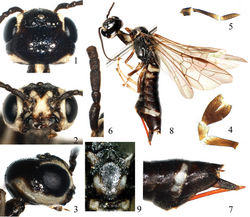Heteroxiphia
| Notice: | This page is derived from the original publication listed below, whose author(s) should always be credited. Further contributors may edit and improve the content of this page and, consequently, need to be credited as well (see page history). Any assessment of factual correctness requires a careful review of the original article as well as of subsequent contributions.
If you are uncertain whether your planned contribution is correct or not, we suggest that you use the associated discussion page instead of editing the page directly. This page should be cited as follows (rationale):
Citation formats to copy and paste
BibTeX: @article{Wei2011ZooKeys102, RIS/ Endnote: TY - JOUR Wikipedia/ Citizendium: <ref name="Wei2011ZooKeys102">{{Citation See also the citation download page at the journal. |
Ordo: Hymenoptera
Familia: Xiphydriidae
Name
Heteroxiphia Saini & Singh, 1987 – Wikispecies link – Pensoft Profile
- Heteroxiphia Saini & Singh, 1987: 356. Type species: Heteroxiphia maai Saini & Singh, 1987, by original designation.
Description
Small, body length 11–13 mm. Clypeus with an acute middle tooth; head almost as broad as thorax, not strongly extended behind eyes, lateral sides roundly narrowed in dorsal view; breadth of upper part of hind orbit distinctly longer than eye breadth but not much longer than long axis of eye; genal carina developed, extending to upper part of hind orbit; occipital carina almost complete, very narrowly separated at posterior margin of postocellar area; temple and postocellar area polished, very sparsely punctured; lower half of hind orbit with longitudinal carinae; distance between antennal sockets 2 times breadth of inner orbit and 2 times distance between antennal socket and anterior margin of clypeus; eyes short elliptical, inner margins indistinctly divergent downward in front view, distance between eyes at level of antennal sockets about 1.4–1.5 times height of eye; malar space (the entire distance from the eye to the lower edge of the antennal groove) distinctly longer than pedicel, about 1.5–2 times diameter of middle ocellus, with a large fovea; frons with curved and irregular carinae and punctures, supraclypeal area with regular longitudinal carinae; mandibles each with four teeth; maxillary palp with 3 palpomeres, first palpomere shortest, second palpomere slender and longest; labial palp with 3 palpomeres, first palpomere slender and longest, third palpomere more or less enlarged with an elliptical disc (sensory pit). Antenna shorter than head and thorax together, weakly compressed, strongly tapering toward apex, with 15–19 antennomeres, third antennomere shorter than 4th and 5th antennomeres together, each antennomere not broader than long. Anterior margin of pronotum deeply and broadly emarginated, middle part of pronotum very narrow; length of propleura in ventral view about 1.5 times as long as broad; mesoscutellum without tubercle, CD= 3.2–3.5; inner tibial spur of front leg bifurcate at apex, outer tibial spur minute; hind femur about 3.5–4 times longer than broad; apical tarsomeres not strongly enlarged; tarsal claws small, inner tooth of fore and middle claws slightly shorter than half length of outer tooth, hind claw with a very small inner tooth. Wings hyaline, forewing with vein 2r present, cell R1 broadly open at apex, anal cell with a cross vein at about apical 1/4; cells R1, Rs, M and A in hind wing closed. Body black with some white maculae.
Distribution
China (Henan, Gansu); India (Himachal Pradesh).
Remarks
Saini and Singh (1987, fig. 3) stated and figured that members of Heteroxiphia have four labial palpomeres. Observation of the labium of the two Chinese species shows that the basal short ring in Fig. 3 of Saini and Singh (1987)[1] is an elevated platform of the labium, thus the labial palp has only three palpomeres.
Heteroxiphia is recognized by a combination of the following characters: maxillary palp with 3 palpomeres, the second palpomere much longer than the first and third palpomeres; labial palp also with 3 palpomeres; hind claw with a minute inner tooth; cell R1 in forewing broadly open, cell R1 in hind wing closed; face and lower half of hind orbit with regular longitudinal carinae; malar space about 1.5 times diameter of middle ocellus and with a large fovea; body black with some white maculae.
Heteroxiphia is closely allied to Trixiphidia Wei, 1999 (Wei and Xiao 1999[2]). These are the only two genera of Xiphydriidae with three maxillary and labial palpomeres. Yangixiphia Wei, 2002 has also three maxillary palpomeres. The following key distinguishes the three genera.
Taxon Treatment
- Wei, M; Niu, G; 2011: Heteroxiphia Saini & Singh (Hymenoptera, Xiphydriidae), a genus new to China with descriptions of two new species ZooKeys, 102: 47-55. doi
Other References
- ↑ Saini M, Singh D (1987) A new genus and a new species of Xiphydriidae (Insecta, Hymenoptera, Symphyta) from India. Zoologica Scripta 16:355-356. doi: 10.1111/j.1463-6409.1987.tb00081.x
- ↑ 2.0 2.1 Wei M, Xiao W (1999) Three new genera and species of Xiphydriidae from south slope of Mt. Funiu (Hymenoptera, Siricomorpha). The Fauna and Taxonomy of Insects in Henan 4:142-148.
Images
|

